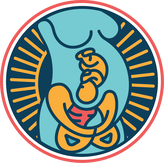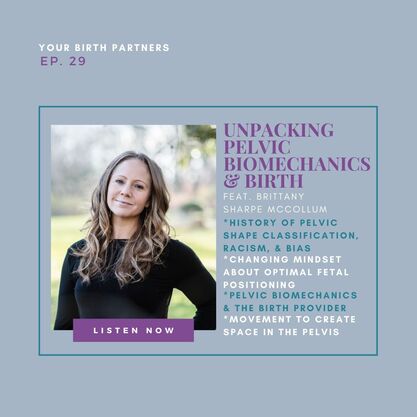Having practiced as a Midwife for 40 years, I was pleased to be learning new things from this presentation. I think every birth provider should see this material. I have retired from full scope midwifery, but am now offering Mindfulness Based Childbirth Education and Parenting classes and this information will be so useful to my students.
- Melissa Lonergan, www.mindfulbirtheducation.com
Pelvic Shape, Fetal Positioning, and Obstetrical Bias:
The Role of Pelvic Classification and Optimal Fetal Positioning
in the Perpetuation of Bias in Childbirth
with Brittany Sharpe McCollum, CCE(BWI), CD(DONA), CPLD, CLC
(a 9 hour workshop divided into two half days)
Our historiographical workshop will change your perception on everything you’ve learned up until this point and will shift the way you support every birth you attend moving forward.
Join Brittany Sharpe McCollum in a deep dive into the history of obstetrics and the role that pelvic classification, the theory of optimal fetal positioning, and scientific racism have played in perpetuating bias and contributing to increased intervention in childbirth through the modern day. This nine hour workshop - divided up into two half day sessions - takes participants on a journey through an obstetrical timeline, exploring and deconstructing the myths surrounding “ideal birthing hips,” “optimal fetal positioning,” x-ray and manual pelvimetry, and posterior babies. Brittany utilizes historical texts, anthropological studies, obstetrical theories and practice, and the foundation of pelvic biomechanics set forth in her Creating Space workshops in an interdisciplinary research-based approach to understanding where these theories began and how they continue to infiltrate childbearing care to this day. This timeline-based approach leads to the understanding of how inaccuracy and naivety filled in a predetermined narrative that shaped bias against certain birthing people and certain fetal positions in modern day obstetrics and midwifery. Bias against posterior fetal positioning is deconstructed and reassembled using up to date research, leaving participants with the tools, skills, and knowledge to support posterior babies in healthy vaginal births.
This workshop is nine hours of intense study, discussion, and practice. Due to the challenging and revelatory nature of the material, the course has been broken up into two half day sessions (four and a half hours each) to leave time for absorption, reflection, and contemplation.
Handouts are included in the workshop and are intended to be used as a reference after completion of the workshop. Our positioning handbooks are available at a discounted rate with the purchase of a workshop ticket.
8 CEs through the PA Board of Nursing have been approved
*Scholarship opportunities for BIPOC birth workers for the Obstetrical Bias workshop are available.
Please complete the form at this link to apply for a scholarship and Brittany will be in touch within a few days.*
This workshop is currently available as a recorded session with two months of unlimited access.
The fee is $175 and includes 8 CEs approved through the PA Board of Nursing.
Contact Brittany to access the course!
This workshop is available in person for hospital groups, private practices, and doula communities.
Contact Brittany to set up a workshop!
The Role of Pelvic Classification and Optimal Fetal Positioning
in the Perpetuation of Bias in Childbirth
with Brittany Sharpe McCollum, CCE(BWI), CD(DONA), CPLD, CLC
(a 9 hour workshop divided into two half days)
Our historiographical workshop will change your perception on everything you’ve learned up until this point and will shift the way you support every birth you attend moving forward.
Join Brittany Sharpe McCollum in a deep dive into the history of obstetrics and the role that pelvic classification, the theory of optimal fetal positioning, and scientific racism have played in perpetuating bias and contributing to increased intervention in childbirth through the modern day. This nine hour workshop - divided up into two half day sessions - takes participants on a journey through an obstetrical timeline, exploring and deconstructing the myths surrounding “ideal birthing hips,” “optimal fetal positioning,” x-ray and manual pelvimetry, and posterior babies. Brittany utilizes historical texts, anthropological studies, obstetrical theories and practice, and the foundation of pelvic biomechanics set forth in her Creating Space workshops in an interdisciplinary research-based approach to understanding where these theories began and how they continue to infiltrate childbearing care to this day. This timeline-based approach leads to the understanding of how inaccuracy and naivety filled in a predetermined narrative that shaped bias against certain birthing people and certain fetal positions in modern day obstetrics and midwifery. Bias against posterior fetal positioning is deconstructed and reassembled using up to date research, leaving participants with the tools, skills, and knowledge to support posterior babies in healthy vaginal births.
This workshop is nine hours of intense study, discussion, and practice. Due to the challenging and revelatory nature of the material, the course has been broken up into two half day sessions (four and a half hours each) to leave time for absorption, reflection, and contemplation.
Handouts are included in the workshop and are intended to be used as a reference after completion of the workshop. Our positioning handbooks are available at a discounted rate with the purchase of a workshop ticket.
8 CEs through the PA Board of Nursing have been approved
*Scholarship opportunities for BIPOC birth workers for the Obstetrical Bias workshop are available.
Please complete the form at this link to apply for a scholarship and Brittany will be in touch within a few days.*
This workshop is currently available as a recorded session with two months of unlimited access.
The fee is $175 and includes 8 CEs approved through the PA Board of Nursing.
Contact Brittany to access the course!
This workshop is available in person for hospital groups, private practices, and doula communities.
Contact Brittany to set up a workshop!
Wow, Brittany! I LOVED this! This explained and answered so many of my questions and observations through my three years as a birth doula. The positions that I observed unmedicated birthing clients naturally taking were often not similar at all to medicated birthing clients, and I wondered why we didn't try to emulate unmedicated positions more closely. This also tracked with my own six experiences of childbirth - first born by cesarean and then five unmedicated VBACs. I will try to suggest incorporating what I now know about posterior babies to relieve the pressure my client feels in needing to turn her baby. You are so incredibly thorough, personable, and sensitive to others' needs. I look forward to taking MANY of your trainings in the future, and I will recommend your workshops to all my birthworker friends! THANK YOU!
- Catherine Young, CD(DONA), CVD TVL, C-VBACS
Birth Doula, Childbirth Educator, VBAC Specialist
https://www.novabirthservices.com/
Facebook and Instagram: Catherine Young Doula Services

